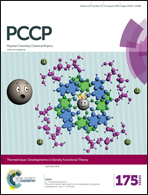The prediction of hole mobility in organic semiconductors and its calibration based on the grain-boundary effect†
Abstract
A new reliable computational model to predict the hole mobility of poly-crystalline organic semiconductors in thin films was developed. Site energy differences and transfer integrals in crystalline morphologies of organic molecules were obtained from quantum chemical calculations, in which periodic boundary conditions were efficiently applied to capture the interactions with the surrounding molecules in the crystalline organic layer. Then the parameters were employed in kinetic Monte Carlo (kMC) simulations to estimate the carrier mobility. Carrier transport in multiple directions has been considered in the kMC simulation to mimic poly-crystalline characteristics under thin-film conditions. Furthermore, the calculated mobility was corrected using a calibration equation based on microscopy images of the thin films to take the effect of grain boundaries into account. As a result, good agreement was observed between the predicted and measured hole mobility values for 21 molecular species: the coefficient of determination (R2) was estimated to be 0.83 and the mean absolute error was 1.32 cm2 V−1 s−1. This numerical approach can be applied to any molecules for which crystal structures are available and will provide a rapid and precise way of predicting device performance.


 Please wait while we load your content...
Please wait while we load your content...